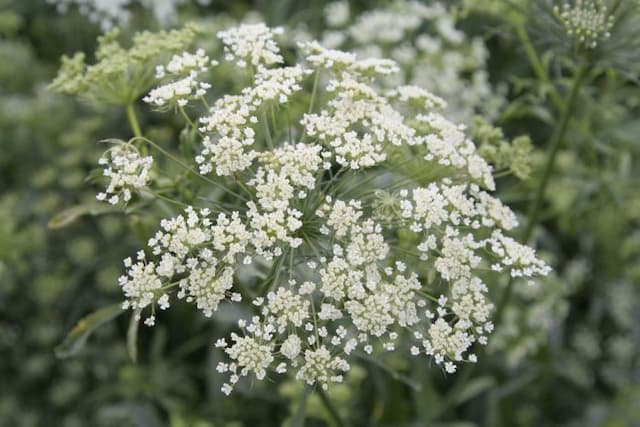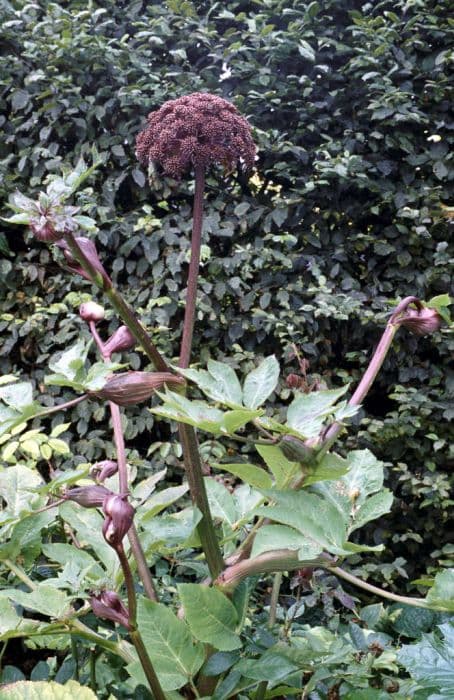Wild Celery Angelica edulis

ABOUT
The plant known as Angelica edulis, commonly referred to as "edulis," has a noticeable upright and structured appearance, prominently featuring compound leaves that are large and divided into smaller leaflets, each boasting toothed edges. These leaves extend outward and upwards from the central stalk, creating a lush and somewhat umbrella-like canopy. The foliage of edulis displays a deep green hue, contributing to its robust and vibrant look. During its blooming period, edulis produces rounded clusters of small, typically greenish or white flowers that further amplify its ornamental appeal. These flower clusters, known as umbels, add to the plant's striking profile as they sit atop the tall stems, creating a delicate contrast against the bold leaves. The overall impression of edulis in the landscape is that of a lush, green presence with intricate leaves and subtle flower clusters that contribute to its charm and availability to provide textural depth in garden design.
About this plant
 Names
NamesSynonyms
Wild Celery, Korean Danggui, Japanese Dystopian
Common names
Angelica edulis Miq., Angelica sylvestris var. edulis (Miq.) F.Schmidt.
 Toxicity
ToxicityTo humans
Angelica edulis, also known as wild celery, has components that can be toxic to humans if consumed in large quantities. It contains furocoumarins, which can cause photosensitivity, leading to skin inflammation and rashes when skin is exposed to sunlight after ingestion. Ingesting large amounts of wild celery can also cause gastrointestinal discomfort as well as nervous system effects such as tremors or seizures. Care should be taken when handling or consuming this plant, and individuals with a known sensitivity should avoid it.
To pets
Angelica edulis, commonly known as wild celery, has the potential to be toxic to pets. Like in humans, the furocoumarins in wild celery can cause photosensitivity in animals, which may result in dermatitis or other skin irritations. If a pet ingests a significant amount of wild celery, it could experience symptoms such as vomiting, diarrhea, and possibly nervous system effects like tremors or seizures. Pet owners should be cautious about allowing their pets to have access to or consume this plant.
 Characteristics
CharacteristicsLife cycle
Biennials
Foliage type
Deciduous
Color of leaves
Green
Flower color
Greenish
Height
6 feet (1.83 meters)
Spread
2 feet (0.61 meters)
Plant type
Herb
Hardiness zones
4
Native area
Asia
Benefits
 General Benefits
General Benefits- Culinary uses: Angelica edulis, commonly known as wild celery, can be used in cooking. Its stalks, leaves, and seeds can add flavor to a variety of dishes.
- Aromatic properties: Wild celery has a unique aroma, making it a pleasant natural fragrance in lotions, perfumes, and soaps.
- Gardening and landscaping: With its tall stature and umbrella-like flower heads, wild celery can be an attractive addition to gardens and landscapes.
- Pollinator attraction: The flowers of Angelica edulis attract beneficial insects, like bees and butterflies, helping to pollinate nearby plants.
- Cultural significance: Wild celery has traditional importance in some cultures where it may be used in ceremonies or as a symbol in various rituals.
 Medical Properties
Medical Properties- Anti-inflammatory effects: Angelica edulis may help reduce inflammation in the body according to some traditional medicine practices.
- Antispasmodic properties: It may alleviate spasms in the muscles and respiratory system.
- Diuretic action: Traditionally, it has been used to promote urine production and relieve fluid retention.
- Expectorant qualities: It may aid in the clearance of mucus from the respiratory tract.
- Digestive aid: Angelica edulis is sometimes used to help with digestive issues like indigestion or to stimulate appetite.
 Air-purifying Qualities
Air-purifying QualitiesThis plant is not specifically known for air purifying qualities.
 Other Uses
Other Uses- Angelica edulis stems are sometimes candied and used as a decorative delicacy on desserts or as a unique sweet treat.
- In some cultures, the roots of Angelica are dried and ground to be used as a flavorful spice in cooking.
- The leaves of the plant can be infused in hot water to create a fragrant herbal tea with an earthy taste.
- Angelica seeds may be used in the production of perfumes due to their aromatic properties.
- Fiber from the stem of Angelica can be used for making paper or in textiles as a natural fiber source.
- The plant is cultivated as an ornamental plant in gardens for its tall stature and umbrella-like flower clusters.
- Dried Angelica can be used in potpourri blends to add a natural, woodsy aroma to a room.
- The hollow stems of Angelica may be used as natural straws or piping tools in culinary arts.
- Angelica leaves have been traditionally used to wrap and preserve butter due to their supposed antibacterial qualities.
- The plant's essential oil can be used in aromatherapy as a calming or grounding scent.
Interesting Facts
 Feng Shui
Feng ShuiThe Angelica is not used in Feng Shui practice.
 Zodiac Sign Compitability
Zodiac Sign CompitabilityThe Angelica is not used in astrology practice.
 Plant Symbolism
Plant Symbolism- Protection: Angelica plants are often associated with safeguarding against negative energies and are believed to ward off evil.
- Healing: Historically, angelica has been used medicinally to treat various ailments, symbolizing health and recovery.
- Purity: The name 'angelica' suggests a link to angels and purity, hence symbolizing innocence and divine purity.
- Heartiness: Angelica edulis grows in difficult conditions, representing resilience and the ability to thrive in adversity.
- Insight: Its connection to spiritual and medicinal use can also symbolize enlightenment and the search for deeper knowledge or truth.
 Water
WaterAngelica, commonly known as Korean angelica, requires consistent moisture, so water it when the top layer of soil feels dry to the touch, usually about once a week. Depending on weather conditions and soil drainage, you may need to adjust this frequency to prevent waterlogging or drying out. Apply water slowly to the base of the plant, allowing it to soak into the soil; avoid overhead watering that wets the foliage. An average-sized angelica may need approximately 1 to 2 gallons per watering session during the growing season, but always check soil moisture before watering.
 Light
LightKorean angelica thrives best in a location with full to partial sunlight. Providing it with about six to eight hours of direct sunlight daily will ensure it grows strong and produces plenty of foliage. If grown in too much shade, the plant may become leggy and weak. The ideal spot for Korean angelica would be an east or west-facing garden where it can receive ample morning light with some afternoon shade or vice versa.
 Temperature
TemperatureKorean angelica prefers cool to moderate temperatures and is hardy in a temperature range from around 50 to 70 degrees Fahrenheit. It can withstand temporary drops down to about 0 degrees Fahrenheit but should be protected from prolonged exposure to freezing temperatures. The ideal growing conditions for Korean angelica include a consistently temperate climate without extreme heat or cold.
 Pruning
PruningKorean angelica doesn't typically require extensive pruning, but to keep the plant healthy and well-shaped, prune away any dead or damaged stems and spent flower heads. Pruning is best done in late winter or early spring before new growth begins. This encourages new shoots to develop and can prevent the plant from becoming too large and unruly.
 Cleaning
CleaningAs needed
 Soil
SoilAngelica edulis, commonly known as wild celery, thrives in a well-draining, fertile, moist soil mix with a pH of 6.0 to 7.0. A good mix might include garden soil, compost, and leaf mold in equal parts to ensure adequate fertility and moisture retention.
 Repotting
RepottingWild celery should be repotted every 1 to 2 years or when it becomes clear that the plant has outgrown its current container, ensuring not to damage the long taproot during the process.
 Humidity & Misting
Humidity & MistingWild celery prefers a high humidity environment, typically around 60-70%, which replicates its natural growing conditions in damp meadows and woodlands.
 Suitable locations
Suitable locationsIndoor
Place wild celery in bright, filtered light and maintain high humidity.
Outdoor
Plant in semi-shade, protect from wind, keep soil moist.
Hardiness zone
4-9 USDA
 Life cycle
Life cycleAngelica edulis, commonly known as Korean angelica or wild celery, begins its life cycle as a seed, which germinates in moist soil with adequate light conditions, typically in the spring. Upon germination, the seedling emerges and develops its first leaves and establishes a root system. As a biennial plant, during its first year, Angelica edulis focuses on vegetative growth, forming a rosette of leaves and storing energy in its root system. In its second year, the plant uses stored energy to shoot up a tall flowering stem, which can reach up to 2 meters, and it produces umbels of small white or greenish flowers that attract pollinators. Following pollination, the flowers develop into oblong seeds that are dispersed by wind, which completes the reproductive phase. Once it has set seed, Angelica edulis typically dies, having completed its life cycle, but its seeds carry the potential to give rise to new plants the following season.
 Propogation
PropogationPropogation time
Spring to early summer
The most popular method of propagating Angelica edulis, also known as the Korean angelica, typically involves the use of its seeds. The optimal time for sowing these seeds is late winter to early spring, just after a period of cold stratification, which helps to break their dormancy. Cold stratification involves chilling the seeds within moistened sand or peat, kept in a refrigerator at around 34 to 41 degrees Fahrenheit (1 to 5 degrees Celsius) for about three to six weeks. Following stratification, the seeds should be sown at a shallow depth of about 1/8 to 1/4 inch (approximately 3 to 6 millimeters) in a well-draining soil mix. Germination may be slow and erratic, but providing consistent moisture and light can improve sprouting rates. After the seedlings become sturdy enough, they can be transplanted to their final location in the garden, ideally under partial shade or in an area that mimics their natural woodland habitat.









